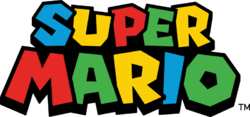| Site Notice |
|---|
|
We have a limited coverage policy. Please check our coverage page to see which articles are allowed. |
Difference between revisions of "Super Mario series"
m (→Games) |
m |
||
| Line 53: | Line 53: | ||
{{GameList/cell|''[[Super Mario 3D Land]]''|2011|2011|2011|2011|2012|[[Nintendo 3DS]]}} | {{GameList/cell|''[[Super Mario 3D Land]]''|2011|2011|2011|2011|2012|[[Nintendo 3DS]]}} | ||
{{GameList/cell|''[[Super Mario 3D World]]''|2013|2013|2013|2013|N/A|[[Nintendo 3DS]]}} | {{GameList/cell|''[[Super Mario 3D World]]''|2013|2013|2013|2013|N/A|[[Nintendo 3DS]]}} | ||
| + | {{GameList/cell|''[[Super Mario Odyssey]]''|2017|2017|2017|2017|N/A|[[Nintendo Switch]]}} | ||
{{GameList/section|colorscheme=Mario|section_title=Edutainment games}} | {{GameList/section|colorscheme=Mario|section_title=Edutainment games}} | ||
{{GameList/cell|''[[Mario is Missing!]]''|N/A|1992|??|??|??|[[PC]] / [[Super Nintendo]] / {{NES}}}} | {{GameList/cell|''[[Mario is Missing!]]''|N/A|1992|??|??|??|[[PC]] / [[Super Nintendo]] / {{NES}}}} | ||
| Line 160: | Line 161: | ||
{{GameList/cell|''[[Mario & Sonic at the Rio 2016 Olympic Games]]''|2016|2016|2016|2016|??|[[Nintendo 3DS]], [[Wii U]], Arcade}} | {{GameList/cell|''[[Mario & Sonic at the Rio 2016 Olympic Games]]''|2016|2016|2016|2016|??|[[Nintendo 3DS]], [[Wii U]], Arcade}} | ||
{{GameList/footer}} | {{GameList/footer}} | ||
| − | |||
| − | |||
| − | |||
| − | |||
| − | |||
==External links== | ==External links== | ||
* {{wp|Mario series|The ''Super Mario'' series on Wikipedia}} | * {{wp|Mario series|The ''Super Mario'' series on Wikipedia}} | ||
* {{sw|Category:Mario|''Mario'' series category on StrategyWiki}} | * {{sw|Category:Mario|''Mario'' series category on StrategyWiki}} | ||
| − | |||
| − | |||
| − | |||
| − | |||
| − | |||
{{-}} | {{-}} | ||
{{Super Mario series}} | {{Super Mario series}} | ||
{{Nintendo flagship series}} | {{Nintendo flagship series}} | ||
[[de:Super Mario (Spieleserie)]] | [[de:Super Mario (Spieleserie)]] | ||
Revision as of 16:21, 13 January 2017
| This article is a short summary of Super Mario series. Super Mario Wiki features a more in-depth article. |
| Super Mario | ||||||||||||||||
| スーパーマリオ Sūpā Mario | ||||||||||||||||
|
| ||||||||||||||||
| ||||||||||||||||
The Super Mario series (alternatively known as the Super Mario Bros. series or simply the Mario series) refers to the overall franchise comprised of a number of series and games based off of the Super Mario Bros. platforming games, and is Nintendo's primary flagship franchise, with new Mario games appearing on all of Nintendo's systems to date since the Nintendo Entertainment System and are frequently launch titles..
The Super Mario series is typically used to refer to the platforming games, on which all other games are based, though the overall franchise also includes series and games such as Mario Kart, Paper Mario, Mario & Luigi, Mario Party and others. With over 200 games and 500 million copies sold between all subsets of the franchise, the Super Mario series is the best-selling video game franchise of all time, with the platforming games alone selling over 310 million units[1]
Overview
| This section is a stub. You can help NintendoWiki by expanding it. |
Arcade
The Super Mario series began with the creation of the 1981 arcade game Donkey Kong, which involved Mario trying to rescue his girlfriend, Pauline, from the Template:Dkw and established the platforming aspect prevalent in much of the series. The character of Mario was originally referred to under the title of Jumpman, and would receive his current name of "Mario" after Nintendo of America's warehouse landlord, Mario Segale.
The Donkey Kong game would later go on to receive two sequels: Donkey Kong Jr. and Donkey Kong 3, which would be spun off into a distinct franchise of Donkey Kong games. After his role as the antagonist of Donkey Kong Jr., Mario would later star in the 1983 arcade title Mario Bros..
Core series
The Super Mario series would begin in its current form in 1985, when the first side-scrolling platform game in the series, Super Mario Bros., was released for the Nintendo Entertainment System. Selling over 40 million copies, Super Mario Bros. would go on to spawn a number of successors. In 1991, Super Mario Land, the series' first handheld installment, was released for the Game Boy, directed by Gunpei Yokoi rather than Miyamoto. The series would later transition into 3D in 1996 with Super Mario 64. Later, after the release of Super Mario Sunshine, the series would return to the 2D gameplay style with the New Super Mario Bros. series, currently spanning four games across four platforms.
The platforming titles have also spun off into their own distinct series. In 1992, Super Mario Land 2: 6 Golden Coins was released, which introduced Wario, a rival character for Mario. Wario would go on to be the star of the game's sequel, Wario Land: Super Mario Land 3, with future sequels using the Wario Land moniker. In addition, Yoshi, Mario's dinosaur partner in Super Mario World, would be the starring character in a number of puzzle games before the 1994 game Super Mario World 2: Yoshi's Island, which spawned the Yoshi's Island series of platforming titles.
Games
External links
|
|
- ↑ Super Mario Maker has sold 1 Million units around the world. Nintendo (September 30, 2015). Retrieved April 14, 2016.






